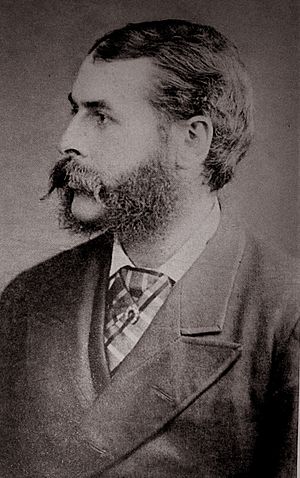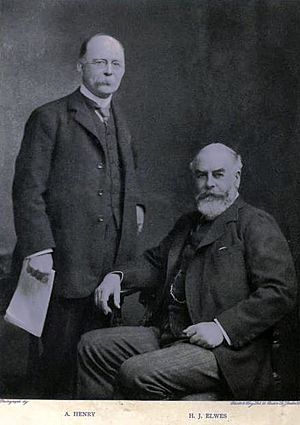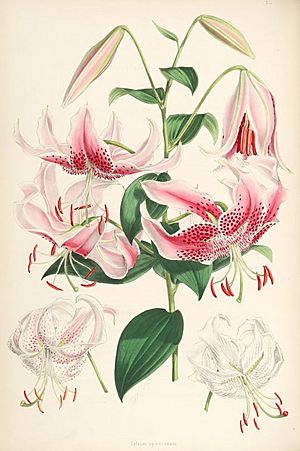Henry John Elwes facts for kids
Quick facts for kids
Henry John Elwes
|
|
|---|---|

Henry John as a young man
|
|
| Born | 16 May 1846 Cheltenham, Gloucestershire, England
|
| Died | 26 November 1922 (aged 76) England
|
| Nationality | British |
| Alma mater | Eton College |
| Known for | Galanthus elwesii Eremurus elwesii Genus Lilium |
| Awards | Victoria Medal |
| Scientific career | |
| Fields | Botany Entomology Lepidoptery Arboriculture |
| Institutions | Royal Horticultural Society |
Henry John Elwes (born May 16, 1846 – died November 26, 1922) was a famous British scientist. He was a botanist, which means he studied plants. He was also an entomologist, meaning he studied insects, especially butterflies. Elwes was known for traveling the world to collect rare plant and insect specimens. He brought back many types of lilies from places like the Himalaya and Korea.
He was one of the first 60 people to receive the Victoria Medal from the Royal Horticultural Society in 1897. Elwes wrote important books like Monograph of the Genus Lilium (1880) and The Trees of Great Britain & Ireland (1906–1913). He also gave a huge collection of 30,000 butterfly specimens to the Natural History Museum in London.
Contents
Henry Elwes' Early Life and Interests
Henry John Elwes was born in Cheltenham, England. He was the oldest son of John Henry Elwes. People described him as a very tall and strong person with a loud voice.
When he was 13, Elwes went to Eton College, a famous school. After he turned 17, he spent time living abroad every year. He studied in Paris, Brussels, and Dresden.
From Soldier to Naturalist
From 1865, Elwes spent five years in the Scots Guards, a part of the British Army. However, he was more interested in ornithology, which is the study of birds. Back then, this often meant collecting bird specimens and their eggs.
In 1869, he left the army. He then lived as a traveling naturalist and a country gentleman. He visited many parts of the world. He studied natural history, including birds, plants, and insects. He also enjoyed big game hunting and managing his family's estate. He even raised prize-winning farm animals.
A Love for Plants
Elwes said his interest in plants came from his wife, Margaret Lowndes, whom he married in 1871. He first had a garden in Miserden. Later, he moved to Preston House. In 1891, he inherited the Colesbourne estate after his father passed away.
Elwes' Scientific Expeditions and Discoveries
In 1870, Henry Elwes joined a special mission to the Sikkim Himalaya. This journey was inspired by reading a book about the Himalayas. It was his first of many trips to Asia. This trip led to his important paper about Asian birds.
From Birds to Butterflies and Plants
After this trip, Elwes became more interested in insects and plants. His expedition to Sikkim alone helped him record nearly 530 types of butterflies.
In 1874, he visited Turkey. On this trip, he focused on collecting plants, especially bulbs. In the mountains near Izmir, he found a beautiful large snowdrop. This snowdrop was later named after him: Galanthus elwesii. He arranged for its bulbs to be collected and sent out. Millions have been exported ever since.
Collecting in Asia and Beyond
In 1880, Elwes traveled to India with his friend Frederick Du Cane Godman. They visited many regions, collecting specimens. Elwes also wrote a book about a type of butterfly called Hesperiidae from Asia.
He also made a trip to the Altai Mountains in 1898. In his book Memoirs (published after he died), he wrote about visiting Nepal in 1914. At that time, very few Europeans were allowed into Nepal.
Plant Breeding and Collections
Elwes was famous for breeding beautiful plants like Nerine and Eremurus. He was especially interested in plants such as Arisaema, Crinum, Crocus, Fritillaria, and Iris. He also loved Kniphofia, Paeonia, and Yucca.
In 1902, Elwes gave his collection of 25,000 moths and butterflies to the Natural History Museum in London. Later, in 1920, another collector bought a large part of Elwes' butterfly collection. Much of this collection also ended up at the Natural History Museum.
Elwes' Major Books
Henry Elwes wrote two very important books that are still used by scientists today.
Monograph of the Genus Lilium
Elwes loved collecting plant bulbs, and he had one of the best private collections. In 1880, he published a magnificent book called Monograph of the Genus Lilium. A monograph is a detailed study of a single subject.
He worked with J. G. Baker from Kew Gardens to write it. Elwes wanted the book to be very accurate and complete. He asked the best plant experts for help. The book also had beautiful, hand-colored illustrations by Walter Hood Fitch. Each lily was shown in its actual size. Elwes was able to grow many types of lilies in his own garden. This helped him become a recognized expert.

After Elwes died in 1922, his friend Arthur Grove helped create a supplement to the book. This supplement added more information and illustrations. The famous artist Lilian Snelling drew most of the new pictures.
The Trees of Great Britain & Ireland
From 1900 to 1913, Elwes worked on his biggest project: The Trees of Great Britain & Ireland. He wrote this book with the botanist Augustine Henry.
In seven large books, they described every type of tree that could grow outdoors in the British Isles. They also recorded the best examples of these trees. Henry created a special system to identify trees using their leaves, twigs, and bud positions. This made it possible to identify trees even without their flowers or fruit.
Elwes visited most of these trees himself. He even wore out two cars doing so! He also traveled abroad to study trees in their natural homes. For example, he went to Chile to see monkey puzzle trees. This work is still a very important source of information about trees and arboriculture (tree cultivation).
Works by Henry John Elwes
- Monograph of the Genus Lilium, London: Taylor and Francis, 1877–80.
- On the Butterflies of Amurlan, North China, and Japan, 1881.
- The Trees of Great Britain & Ireland (with Augustine Henry), 1906.
- On the Lepidopteren of the Altai Mountains, 1899.
- Memoirs of Travel, Sport, and Natural History, Edited posthumously by E. G. Hawke. Benn, London, 1930.
Images for kids




